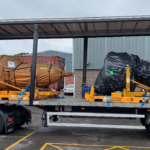Katherine Simmons talks to Sameer Savani, Head of Innovation and Engineering at ADS, about what delegates can expect from the Global Urban Air Summit 2019
From innovation to regulation, physical to digital infrastructure, all of the challenges for the air mobility sector will be up for discussion next week at the inaugural Global Urban Air Summit (GUAS).
The event will include two days of conference sessions, networking, knowledge sharing and demonstrations, with the international community brought together by GUAS set to play a key strategic role in driving the industry forward. The event will showcase the latest innovations in global air mobility and discuss all of the elements which will shape the future of air travel.
Sameer Savani, Head of Innovation and Engineering at ADS, outlines what delegates can expect from this brand new event to FINN’s Katherine Simmons (KS).
KS: This is the first edition of GUAS. What will delegates experience at this inaugural event?
SS: GUAS is a conference-led event which will bring together a mix of keynote speakers and key players within the industry. It will bring together discussions and panel debates which will stimulate conversation between the key stakeholders.
There will be an exhibition and workshop sessions on the second day which will be the catalyst for debate in key topics, these will offer something different from the traditional conference sessions.
KS: Can you outline some of the biggest topics which will be covered at GUAS?
SS: One of the biggest areas for discussion will be around markets. It really comes down to understanding the market, the size of the market and where the real value proposition will be.
As well as the operators, we will be focusing on the complex regulatory environment. This is not just in relation to the vehicles, but also with regards to how it links up to existing and new infrastructure as well as other environments, for example, how urban air will integrate with motor vehicles and airport facilities. All of those elements cluster together as enablers of the sector, as well as the vehicles themselves.
There is a need for both physical and digital infrastructure plus support requirements and how all of these different aspects merge together to drive this forward – a third of the sessions will cover this topic.
KS: Describe some of the key challenges which will be discussed for: innovators, regulators and government?
SS: Innovators will have to gain and understanding of what it means to be in aviation, which is a highly regulated and safety driven industry. It is a new experience for them, learning how aviation works. Regulators can enable innovation. There is a real opportunity to work with innovators, ensuring key processes and competitive support are in place.
There are around 170 urban air concept aircraft around the world at the moment. At some point these will consolidate into fewer models and this will depend on understanding the type of vehicle needed and how this will develop. We need to understand first where the ‘sweet spots’ are and what the system of the future should look like.
Another challenge is around understanding the part of the sector which other people want to play in. There’s no credible indication yet that it will be those making the vehicles will make money. As yet, it is unclear where the value in the sector will be which will determine what part people will be investing in.
The UK government is investing in the sector, but it won’t be enough to help shape regulation to ensure and enable the infrastructure and facilities. However, it can also be a useful source of public source data, such as that provided by Transport for London on passenger numbers and this can be made public to innovators.
KS: What part will GUAS play in driving forward the strategic development of the urban air mobility sector?
GUAS is the first event of its kind in a sector is increasingly building interest. It will be a strategic event but we want to concentrate more on practical engagement within the sector.
The key will be ensuring sure there is a 365 days a year approach to this event. We want that engagement to carry on through Farnborough, through ADS and through key industry followers. We have to look at building communities of interest throughout the year. The event is being developed with key government departments, and, unlike others within the sector, we have also made it affordable for anyone interested in the issues which will be covered.
In terms of how it fits with Farnborough International, two years is a long time within the sector – urban air mobility is closer to the automotive sector in terms of developments and in terms of the speed it moves.

